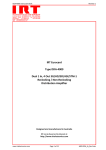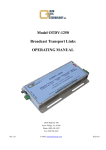Download DDT-4624 & DDR-4624 User Manual
Transcript
DDT-4624 & DDR-4624 Quad 3G/HD/SD-SDI/ASI Fibre Optic Link User Manual IRT Electronics Pty Ltd | www.irtelectronics.com Revision 00 DDT-4624 & DDR-4624 QUAD 3G/HD/SD-SDI/ASI FIBRE OPTIC LINK Revision History: Revision 00 Date 12/06/2012 By AL Change Description Original Issue. Applicable to: Serial numbers >1201001 IRT Electronics Pty Ltd | www.irtelectronics.com Page 2 of 15 Revision 00 DDT-4624 & DDR-4624 USER MANUAL Table of Contents: Section Page Revision History Operational Safety General Description Technical Specifications Configuration Installation Signal Connections Front and rear layouts Operation SNMP – What Is It? SNMP Functions DDT-4624 DDR-4624 Maintenance & Storage Warranty & Service Equipment return 2 4 5 6 7 8 8 9 10 11 13 13 14 15 15 15 This instruction book applies to serial numbers > 1201001. IRT Electronics Pty Ltd | www.irtelectronics.com Page 3 of 15 Revision 00 DDT-4624 & DDR-4624 OPERATIONAL SAFETY WARNING Operation of electronic equipment involves the use of voltages and currents that may be dangerous to human life. Note that under certain conditions dangerous potentials may exist in some circuits when power controls are in the OFF position. Maintenance personnel should observe all safety regulations. Do not make any adjustments inside equipment with power ON unless proper precautions are observed. All internal adjustments should only be made by suitably qualified personnel. All operational adjustments are available externally without the need for removing covers or use of extender cards. Optical Safety The light emitted from the LASER diode used in this system is invisible and may be harmful to the human eye. Avoid looking directly into the fibre optic cable or connectors or into the collimated beam along their axis when the device is in operation. Operating the LASER diode outside of its maximum ratings may cause device failure or a safety hazard. DANGER Invisible LASER radiationAvoid direct exposure to beam Peak power Wavelength 2 mW 1270–1610nm Class 1 LASER Product IRT Electronics Pty Ltd | www.irtelectronics.com Page 4 of 15 Revision 00 DDT-4624 & DDR-4624 GENERAL DESCRIPTION BLOCK DIAGRAM DDT-4624 & DDR-4624 SIGNAL PATH 3G-SDI HD-SDI SD-SDI ASI DDT-4624 DDR-4624 I/P 1 Fibre 1 O/P I/P 2 Fibre 2 O/P I/P 3 Fibre 3 O/P I/P 4 Fibre 4 O/P O/P 1 Fibre 1 I/P O/P 2 Fibre 2 I/P O/P 3 Fibre 3 I/P O/P 4 Fibre 4 I/P SNMP Fibre Link * 9-27 dB path loss at 3G (>30dB at HD and SD) 3G-SDI HD-SDI SD-SDI ASI SNMP NOTE: * Fitted with APD detector. 3-18dB when fitted with PIN detector. The IRT DDT-4624 and DDR-4624 are quad transmit and receive modules designed principally for use as four independent serial data fibre optic transmission links for 3G-SDI, HD-SDI or SD-SDI applications conforming to SMPTE standards 424M, 292M and 259M using 9/125 µm single mode fibre. In addition, the link may be used for ASI transport streams for use with MPEG compressed video streams or other 270 Mb/s type data. The transmitter features automatic input cable equalisation. The unit can be configured, at time of order, with lasers of various wavelengths for use with a CWDM system. The receiver uses a choice of either a PIN photodiode or APD detectors with signal conditioning and reclocking circuits. The data rates are automatically set to match the 3G-SDI, HD-SDI or SD-SDI/ASI rates dependent on the actual input data rates to the transmitter. The transmitter and receiver modules are compatible with IRT’s single channel fibre cards for use as four independent fibre paths starting from or coming to a single location. LED indicators are provided on both modules for digital signal presence and power. Both the DDT-4624 and DDR-4624 are fully hot pluggable with the fibre connections being independent of the main card being connected solely to the modules rear assembly. SNMP (Simple Network Management Protocol) is available for monitoring and control when used in an IRT frame fitted with SNMP capability. The DDT-4624 and DDR-4624 are Eurocard modules designed to fit IRT’s current range of standard Eurocard frames and may be used alongside any other of IRT’s analogue or digital Eurocards. Standard features: • • • • • 4 independent fibre links. Transports 2.97 Gb/s 3G-SDI, 1.485 Mb/s HD-SDI or 270 Mb/s SD-SDI & ASI signals. Hot pluggable fibre connections. Various independent wavelength options available for use with a CWDM system. Transmitter (Tx) and receiver (Rx) can be used separately with 4 independent single channel fibre Rx and Tx cards. IRT Electronics Pty Ltd | www.irtelectronics.com Page 5 of 15 Revision 00 DDT-4624 & DDR-4624 TECHNICAL SPECIFICATIONS DDT-4624: Input serial data signal Input impedance Input return loss Automatic Cable compensation Input Connector 2.97 Gb/s (3G-SDI) to SMPTE 424M; 1.485 Gb/s (HD-SDI) to SMPTE 292M; 270 Mb/s (SD-SDI) to SMPTE 259M and DVB-ASI. 75 Ω. > 15 dB 5 MHz to 1.5 GHz, > 10 dB 1.5 GHz to 2.97 GHz. > 100 m at 2.97 Gb/s with Belden 1694A (typ. 130m); > 100 m at 1.485 Gb/s with Belden 1694A (typ. 170m); > 250 m at 270 Mb/s with Belden 8281 (typ. > 300m). 4 (1 per channel), BNC on rear panel. DDR-4624: Number of outputs Output level Output impedance Output return loss Output Rise and Fall Time Intrinsic Jitter Output Connector 1 data reclocked, AC coupled. 800 mV ± 10%. 75 Ω. > 15 dB 5 MHz to 1.5 GHz; > 10 dB 1.5 GHz to 2.97 GHz. < 135 ps at 2.97 Gb/s and 1.485 Gb/s; > 0.4 ns and < 1.5 ns at 270 Mb/s. < 0.3 UI at 2.97 Gb/s reclocked; < 0.2 UI at 1.485 Gb/s reclocked; < 0.2 UI at 270 Mb/s reclocked (typically < 0.1 UI). 4 (1 per channel), BNC on rear assembly. Optical: DDT-4624 optical output DDR-4624 optical input Available wavelengths 1 Optical path loss Optical fibre Optical connectors 0 dBm +4.5/-0 dB CWDM DFB laser. APD detector, -9 to -27 dBm input level at 3G-SDI, typically < -30 dBm at HD/SD-SDI. PIN detector, -3 to -18 dBm input level. CWDM DFB laser - 1270nm, 1290nm, 1310nm 1330nm, 1350nm, 1410nm, 1430nm, 1450nm, 1470nm, 1490nm, 1510nm, 1530nm, 1550nm, 1570nm, 1590nm & 1610nm. 9 to 27 dB at 3G-SDI, typically > 30 dB at HD/SD-SDI, APD detector; 3 to 18 dB PIN detector. (Optical path loss = Laser O/P power – Detector I/P power) Designed for use with 9/125 µm single mode fibre. 4 (1 per channel), LC/PC on rear assembly. Power Requirements: 28 Vac CT (14-0-14) or ±16 Vdc. DDT-4624 <6.0 VA, DDR-4624 <6.5 VA. Voltage Power consumption Other: Temperature range Mechanical Finish Front panel Rear assembly Dimensions Optional accessories NOTE: 1 0 - 50° C ambient. For mounting in IRT 19" rack chassis with input, output and power connections on the rear panel. Grey background, black lettering & red IRT logo. Detachable silk-screened PCB with direct mount connectors to Eurocard and external signals. 6 HP x 3 U x 220 mm IRT Eurocard. SMU-4000 SNMP plug in module for use with 4000 series frame fitted with SNMP “Agent”. Typical values based using DFB laser. Optical attenuator required for DDR-4624 when optical path loss is less than 3dB for PIN detector and 9dB for APD detector. Due to our policy of continuing development, these specifications are subject to change without notice. IRT Electronics Pty Ltd | www.irtelectronics.com Page 6 of 15 Revision 00 DDT-4624 & DDR-4624 CONFIGURATION DIP switch settings: DDT-4624: ON DIP SW1 1 2 3 4 5 6 7 8 SW1-1 OFF Disable ‘Keep Alive’ signal on Channel 1. ON Enable ‘Keep Alive’ signal on Channel 1 SW1-2 OFF Disable ‘Keep Alive’ signal on Channel 2. ON Enable ‘Keep Alive’ signal on Channel 2. Requires SW1-7 ON to be active. SW1-3 OFF Disable ‘Keep Alive’ signal on Channel 3. ON Enable ‘Keep Alive’ signal on Channel 3. SW1-4 OFF Disable ‘Keep Alive’ signal on Channel 4. ON Enable ‘Keep Alive’ signal on Channel 4. SW1-5 Not Used. SW1-6 Not Used. SW1-7 OFF Enable SNMP control. ON Enable DIP switch control. 2 SW1-8 OFF Enable major and minor SNMP alarms to the frame Agent (CDM card) . 2 ON Disable major and minor SNMP alarms to the frame Agent (CDM card) . DDR-4624: SW2 SW1 ON ON DIP 1 2 3 4 5 6 7 8 DIP 1 2 3 4 5 6 7 8 DATA RATE Auto Detect SD-SDI / ASI HD-SDI 3G-SDI CHANNEL 1 SW1-1 SW1-2 OFF OFF ON OFF OFF ON ON ON CHANNEL 2 SW1-3 SW1-4 OFF OFF ON OFF OFF ON ON ON CHANNEL 3 SW1-5 SW1-6 OFF OFF ON OFF OFF ON ON ON CHANNEL 4 SW1-7 SW1-8 OFF OFF ON OFF OFF ON ON ON RECLOCKER Enabled Bypassed CHANNEL 1 SW2-1 OFF ON CHANNEL 2 SW2-2 OFF ON CHANNEL 3 SW2-3 OFF ON CHANNEL 4 SW2-4 OFF ON SW1-5 Not Used. SW1-6 Not Used. SW1-7 OFF Enable SNMP control. ON Enable DIP switch control. 2 SW1-8 OFF Enable major and minor SNMP alarms to the frame Agent (CDM card) . 2 ON Disable major and minor SNMP alarms to the frame Agent (CDM card) . NOTE: 2 When using TRAPS via SNMP, depending on how system is set up, in order to avoid double reporting of alarms via the DDT-4620 and DDR-4620 cards themselves and the CDM card (SNMP Agent) of the frame, major and minor SNMP alarms that are reported to the CDM card of the frame can be disabled. IRT Electronics Pty Ltd | www.irtelectronics.com Page 7 of 15 Revision 00 DDT-4624 & DDR-4624 INSTALLATION Pre-installation: Handling: This equipment may contain or be connected to static sensitive devices and proper static free handling precautions should be observed. Where individual circuit cards are stored, they should be placed in antistatic bags. Proper antistatic procedures should be followed when inserting or removing cards from these bags. Power: AC mains supply: Ensure that operating voltage of unit and local supply voltage match and that correct rating fuse is installed for local supply. DC supply: Ensure that the correct polarity is observed and that DC supply voltage is maintained within the operating range specified. Earthing: The earth path is dependent on the type of frame selected. In every case particular care should be taken to ensure that the frame is connected to earth for safety reasons. See frame manual for details. Signal earth: For safety reasons a connection is made between signal earth and chassis earth. No attempt should be made to break this connection. Installation in frame or chassis: See details in separate manual for selected frame type. Signal Connections: The DDT-4624 and DDR-4625 are set up to automatically or manually operate at either 3G-SDI, HD-SDI or SD-SDI / ASI signal rates and do not require any adjustment prior to use, with the exception the DIP switch options described in the Configuration section of this manual. There are no external controls on the front panel of the units. Optical connections are made via LC/PC optical connectors mounted on the rear of the modules. Care must be taken to provide a clean surface on the optical connectors and in inserting the plug on the external fibre to prevent damage to the alignment ferrule of the panel adapter. Type of fibre used must be single mode type. The serial digital signal connections are made to the BNC connectors on the rear panels. External alarm contact connections to the DDR-4624 are made to the 5 pin phoenix style connector at the bottom of the rear assembly. On an alarm condition relay contacts go open circuit, that is switch open with respect to ground, when the input optical signal level is low or not present. The connections being: 1 OPTICAL I/P 1 ALARM 2 OPTICAL I/P 2 ALARM 3 OPTICAL I/P 3 ALARM 4 OPTICAL I/P 4 ALARM 5 GND Note that the DDT-4624 is not equipped with an external alarm connector. IRT Electronics Pty Ltd | www.irtelectronics.com Page 8 of 15 Revision 00 DDT-4624 & DDR-4624 Front & rear panel connector diagrams: IRT Electronics Pty Ltd | www.irtelectronics.com Page 9 of 15 Revision 00 DDT-4624 & DDR-4624 OPERATION The DDT-4624 and DDR-4624 are set up to operate either automatically or at fixed rates corresponding to 3G-SDI, HD-SDI or SD-SDI (or ASI) rates. Up to four independent 3G-SDI, HD-SDI, SD-SDI or ASI signals are connected to the four 75 Ω BNC connectors on the rear assembly of the DDT-4624 fibre optic transmitter. Front panel LEDs indicates the presence of valid input signals. On loss of an input signal, a 54MHz oscillator can be switched into the optical output so that the DDR-4624 still recognizes the optical link as being valid. This 54MHz signal does not affect the signal reclocking detect circuitry of the DDR-4624, which is used in signal presence/alarm indication on detection or absence of a valid 3G, HD or SD signals. Single mode optical cable is directly connected to the rear assembly of the units. This connector is separate from the main module allowing the card to be hot-pluggable in the field without the need of first disconnecting the optical connections. The system will operate with an optical path loss from 9dB to a maximum of 27dB (for 3G-SDI signals. Typically >30dB for HD/SD-SDI signals) when fitted with an APD detectors, and from 3dB to a maximum of 18dB when fitted with a PIN detectors. For path lengths <9dB optical loss when using an APD detector or <3dB optical loss when using a PIN detector, an optical attenuator is required. The length of fibre that this corresponds to depends on the fibre loss characteristics at the relevant wavelength of the laser module chosen. For example, if the fibre loss characteristic of the chosen fibre is 0.2dB per kilometre at 1550 nm, say, then the maximum distance that can be -1 run is 125 km (25dB/0.2dBkm ), although connector losses, such as through patch leads etc., should also be taken into consideration when calculating maximum distances. Actual attenuation versus wavelength characteristics depends upon optic fibre manufacturer’s own specifications. The DDR-4624 receiver module accepts an input optical signal with a power level in the range of -9 dBm to -27 dBm (for 3G-SDI signals. Typically <-30dBm for HD/SD-SDI signals) when fitted with an APD detector, and -3 dB to -18 dB when fitted with a PIN detector. A relay alarm accessible by the rear assembly indicates when the optical path loss is approaching, or has exceeded, the maximum allowed. The output of the DDR-4624 receiver is the same signal that was originally inputted to the DDT-4624 transmitter. A front panel green LED, and a relay alarm accessible by the rear assembly, indicates the presence of a valid locked output signal. The DDT-4624 is equipped with four independent wavelengths (1510nm, 1530nm, 1550nm and 1570nm as standard) allowing the unit to be interfaced with IRT’s 4 or 8-way CWDM Fibre Muxes allowing four independent signals to be multiplexed on a single fibre. Other wavelength combinations are available upon request. Both the DDT-4624 and DDR-4624 are compatible with IRT’s single channel digital fibre links. IRT Electronics Pty Ltd | www.irtelectronics.com Page 10 of 15 Revision 00 DDT-4624 & DDR-4624 SNMP What Is It? SNMP stands for Simple Network Management Protocol. It is an application layer protocol for managing IP (Internet Protocol) based systems. SNMP enables system administrators to manage system performance, and to find and solve system problems. SNMP runs over UDP (User Datagram Protocol), which in turn runs over IP. Three types of SNMP exist: SNMP version 1 (SNMPv1), SNMP version 2 (SNMPv2) and SNMP version 3 (SNMPv3). It is not the intention here to discuss the differences between various versions, only to bring attention to the fact that IRT Electronics modules, fitted with SNMP capability, use SNMPv1. An SNMP managed network consists of three key components: Network Management Systems (NMS), agents, and managed devices. An NMS is the console through which the network administrator performs network management functions, such as monitoring status (e.g. alarm states) and remote controlling, of a set of managed devices. One or more NMS’s must exist on any managed network. Generally the NMS is a computer running third party SNMP control software. There are a number of third party SNMP software applications currently available on the market. An NMS polls, or communicates with, an agent. An agent is a network management software module that resides in a managed device. An agent has local knowledge of management information and translates that information into a form compatible with SNMP. The agent, therefore, acts as an interface between the NMS and the managed devices. The NMS sends a request message, and control commands for the managed devices, to the agent, which in turn sends a response message, containing information about the managed devices, back to the NMS. A managed device contains an SNMP agent and resides on a managed network. Managed devices collect and store management information and make this information available to NMS’s using SNMP. Managed device agent variables are organised in a tree structure known as a Management Information Base (MIB). Within the MIB are parameters pertaining to the managed device. An Object Identifier (OID) number within the MIB defines the managed device type. This is a unique number specific to the model of managed device. Other information relating to the device is also stored, information such as alarm states, controllable settings, etc. The MIB tree is organised in such a way that there will be no two MIB files with conflicting placements. Normally an NMS polls an agent for information relating to the MIB in a managed device to be sent back to the NMS. When certain conditions are met within the MIB, such as major alarm conditions, for example, the agent automatically sends what is known as a trap to the NMS without any prompting from the NMS. This allows automatic notification of a predetermined event. SNMP Block Diagram NMS IP Network NMS SNMP Agent Protocol Engine MIB SNMP Agent SNMP Agent Protocol Engine MIB SNMP Agent SNMP Agent Protocol Engine MIB SNMP Agent IRT Electronics Pty Ltd | www.irtelectronics.com Page 11 of 15 Revision 00 DDT-4624 & DDR-4624 SNMP with IRT Products: IRT Electronics currently employs SNMPv1 with its SNMP capable frames. The frame acts as an agent when fitted with a CDM-xxxx module. This module has its own designated slot next to the power supply so as to not affect the number of modules that the frame will take. Communication between the NMS, the frame and its loaded modules are via this CDM-xxxx module. Note that the NMS software is third party and not supplied by IRT Electronics. Ethernet connection for SNMP operation is via an RJ45 connector on the rear of the frame, below the mains inlet. Ethernet rate runs at either 10 baseT or 100 baseT. Frame parameters, such as Name, Address and Location, are set via an RS232 interface, a D9 connector on the rear of the frame below the mains inlet. A software terminal emulator, such as Tera Term or HyperTerminal, is used for setting and reading the parameters of the frame. IRT modules that are SNMP compatible need a plug-in SMU-4000 module with a program relevant to the module that it is plugged into. Depending on the module, besides the module identification, parameters such as alarm states, inputs and controls etc. are communicated to the CDM-xxxx agent via a data bus on the rear of the frame. Thus the CDM-xxxx collects information on what is loaded within the frame, what positions they occupy, and their current status for communication to the NMS when the NMS sends a request for information. In the event of a major alarm from any of the SNMP compatible modules, or power supplies, a trap is automatically sent by the CDM-xxxx agent to the NMS without any prompting by the NMS. This alerts the operator to any fault conditions that may exist that need immediate attention. 110/240 V 50/60 Hz 0.7 A (max.) FRU-4000 FRAME FUSES 220/240 Vac 500 mA S.B. 110/120 Vac 1A S.B. RS232 Alarm Ethernet + 48Vdc AS3260 approval no.: CS6346N Ass. no.: 804692 IRT SNMP Connections NMS Ethernet Cable IP Network IRT modules fitted with SMU-4000 CDM-xxxx PSU’s IRT SNMP Frame Ethernet Cable IRT modules fitted with SMU-4000 CDM-xxxx PSU’s IRT SNMP Frame Ethernet Cable IRT SNMP Setup IRT Electronics Pty Ltd | www.irtelectronics.com Page 12 of 15 Revision 00 DDT-4624 & DDR-4624 DDT-4624 & DDR-46240 SNMP Functions: With the DDT-4624 and DDR-4624 installed in an IRT frame with SNMP capability, these can be interrogated by an SNMP Network Management System (NMS). 3 The following SNMP functions are capable of being monitored and controlled by an NMS: DDT-4620: alarms - An indication of the state of alarm, (1) noAlarms: No alarms present. (2) UrgentAlarm: Corresponds to a laser failure. controlSource - An indication of the source for board control settings, (1) localDIPsw: DIP switch control (SW1-7 ON). (2) remoteSNMP: SNMP control (SW1-7 OFF). channelInfoTable - Information on each input in table form: channelNumber - Input channel number (1, 2, 3 and 4). channelPresent - An indication that the channel input signal is present or not: (1) notPresent: No input signal present on channel. (2) present: Input signal is present on channel. channelWavelength - An indication of the channel laser wavelength. channelKeepAlive - An indication, and setting, whether the channel has a Keep Alive signal present or not. (1) off: Keep Alive signal not active. (2) on: Keep Alive signal is active. channelAlias - A 15 byte maximum Alias (name) for the channel can be read and set. channelTrapEnable - Trap automatically sent, if enabled, when a channel is first present and when it is first absent. (1) notEnabled. (2) enabled. fpgaVersion - The firmware version of the main FPGA in the format ‘x.y’, where x is the major revision number and y the minor. softwareVersion - The software version of the main FPGA in the format ‘x.y’, where x is the major revision number and y the minor. reset - Unit reset control. A set with a value of 2 sent to this OID will cause a system reset to occur. When queried returns a 1. NOTE: 3 For SNMP control, DIP switch SW1-7 of the relevant card must be in the OFF position. IRT Electronics Pty Ltd | www.irtelectronics.com Page 13 of 15 Revision 00 DDT-4624 & DDR-4624 DDR-4620: ctrlMode channelTable - An indication of the source for board control settings, (1) remoteSNMP: SNMP control (SW1-7 OFF). (2) pcbSwitches: DIP switch control (SW1-7 ON). - Information on each input in table form: channelNumber - Input channel number (1, 2, 3 and 4). status - An indication of the channel status: (1) unlocked: Reclocker cannot lock to the channel signal data rate, or no signal actually exists on the channel. (2) locked270Mbps: Signal present on channel is locked to the 270Mb/s rate (such as SD-SDI or ASI). (3) lockedSDI-HD: Signal present on channel is locked to the HD-SDI rate. (4) lockedSDI-3G: Signal present on channel is locked to the 3G-SDI rate. opticalRx - An indication of the received optical input power (±3dBm accuracy). dataRate - An indication, and setting, of the channel data rate reclocker. (1) autoDetect: The reclocker is automatically set to what the signal data rate is (3G, HD or SD data rate). (2) mbps270: The reclocker is set to lock at 270Mb/s rate to suit SD-SDI or ASI types of signals. (3) sdi-HD: The reclocker is set to lock at the HD-SDI rate. (4) sdi-3G: The reclocker is set to lock at the 3D-SDI rate. reclocker - An indication, and setting, of whether the reclocker is enabled or not. (1) enabled: The reclocker is enabled so as to lock to 3G, HD or SD data rates, dependent on the ‘dataRate’ setting. (2) bypassed: The reclocker is bypassed. channelAlias - A 15 byte maximum Alias (name) for the channel can be read and set. statusTrapEnable - Trap automatically sent, if enabled, when a channel status changes. (1) disEnabled. (2) enabled. fpgaVersion - The firmware version of the main FPGA in the format ‘x.y’, where x is the major revision number and y the minor. softwareVersion - The software version of the main FPGA in the format ‘x.y’, where x is the major revision number and y the minor. reset - Unit reset control. A set with a value of 2 sent to this OID will cause a system reset to occur. When queried returns a 1. IRT Electronics Pty Ltd | www.irtelectronics.com Page 14 of 15 Revision 00 DDT-4624 & DDR-4624 MAINTENANCE & STORAGE Maintenance: No regular maintenance is required. Care however should be taken to ensure that all connectors are kept clean and free from contamination of any kind. This is especially important in fibre optic equipment where cleanliness of optical connections is critical to performance. Storage: If the equipment is not to be used for an extended period, it is recommended the whole unit be placed in a sealed plastic bag to prevent dust contamination. In areas of high humidity a suitably sized bag of silica gel should be included to deter corrosion. Where individual circuit cards are stored, they should be placed in antistatic bags. Proper antistatic procedures should be followed when inserting or removing cards from these bags. WARRANTY & SERVICE Equipment is covered by a limited warranty period of three years from date of first delivery unless contrary conditions apply under a particular contract of supply. For situations when “No Fault Found” for repairs, a minimum charge of 1 hour’s labour, at IRT’s current labour charge rate, will apply, whether the equipment is within the warranty period or not. Equipment warranty is limited to faults attributable to defects in original design or manufacture. Warranty on components shall be extended by IRT only to the extent obtainable from the component supplier. Equipment return: Before arranging service, ensure that the fault is in the unit to be serviced and not in associated equipment. If possible, confirm this by substitution. Before returning equipment contact should be made with IRT or your local agent to determine whether the equipment can be serviced in the field or should be returned for repair. The equipment should be properly packed for return observing antistatic procedures. The following information should accompany the unit to be returned: 1. 2. 3. 4. 5. 6. 7. A fault report should be included indicating the nature of the fault The operating conditions under which the fault initially occurred. Any additional information, which may be of assistance in fault location and remedy. A contact name and telephone and fax numbers. Details of payment method for items not covered by warranty. Full return address. For situations when “No Fault Found” for repairs, a minimum charge of 1 hour’s labour will apply, whether the equipment is within the warranty period or not. Contact IRT for current hourly rate. Please note that all freight charges are the responsibility of the customer. The equipment should be returned to the agent who originally supplied the equipment or, where this is not possible, to IRT directly. Details of IRT’s direct address can be found at IRT Electronics’ website. Web address: www.irtelectronics.com Email: [email protected] IRT Electronics Pty Ltd | www.irtelectronics.com Page 15 of 15 Revision 00































